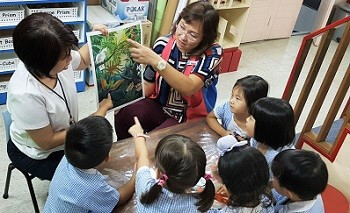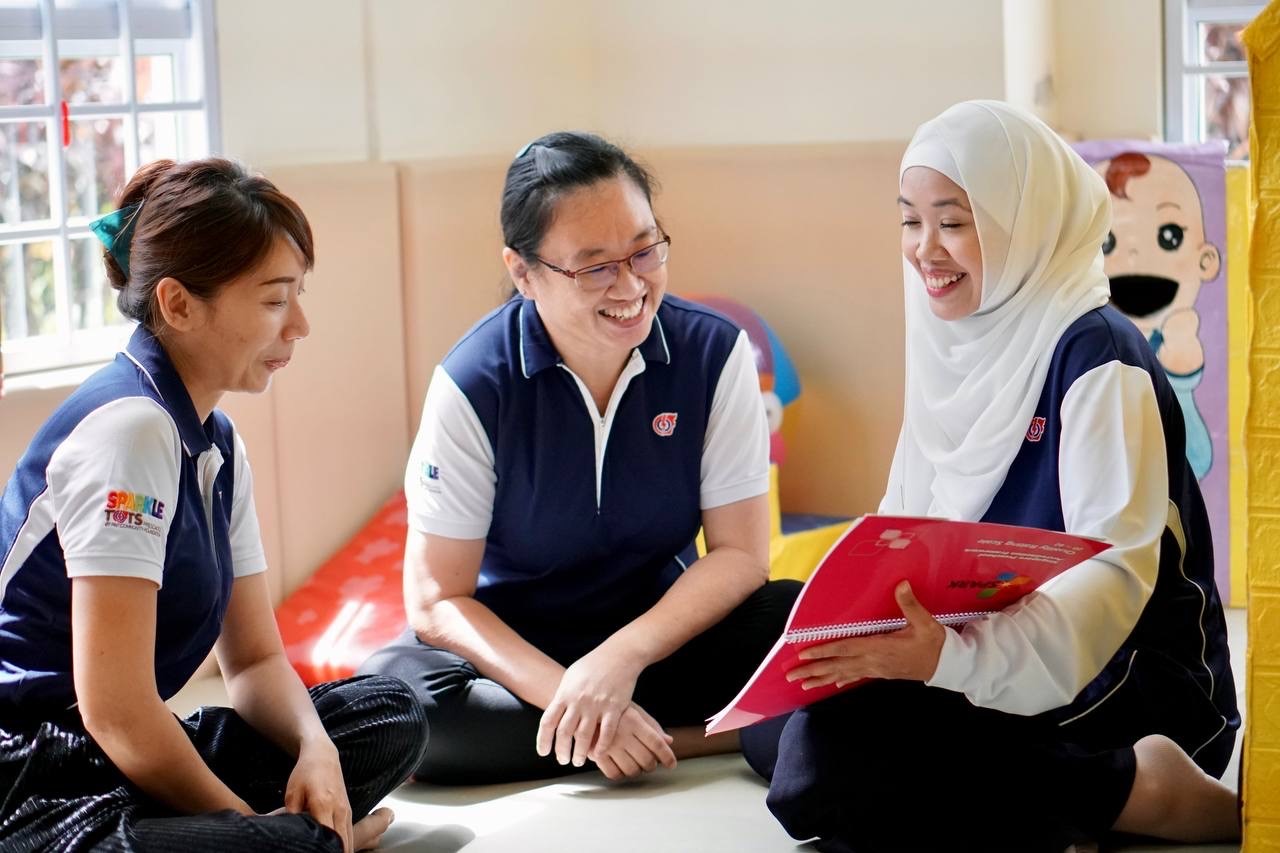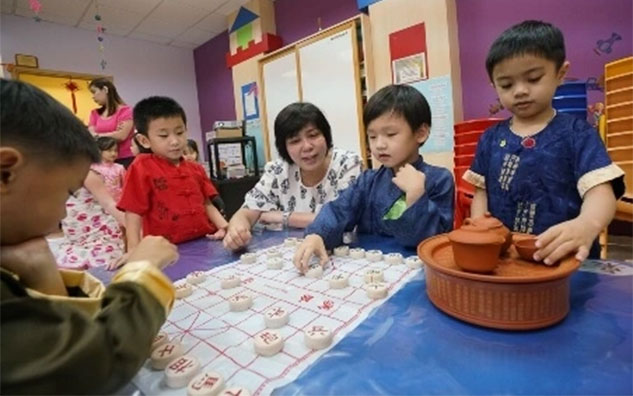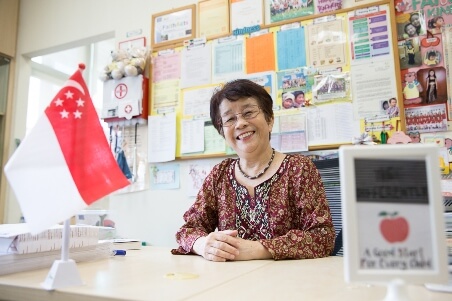Observing Children's Learning Through Art Viewing

To ECDA Fellow Dr Jacqueline Chung, early childhood educators can nurture young children’s love for the Arts not only through creating art but also through viewing and appreciation of art. An avid fan of the Arts herself, Dr Chung works closely with early childhood leaders through the Inquiry-Based Action Plan (IBAP) project to equip them with the necessary knowledge and skills to facilitate young children’s learning through art viewing.

For Dr Jacqueline Chung, ECDA Fellow and Senior Principal and Academic Director at St James’ Church Kindergarten, the Arts has always held a dear place in her heart. From a young age, she has been immersed in various forms of the Arts, from literature to music, dance, drama and the visual arts. This passion led her to focus on the Visual Arts in early childhood education for her PhD thesis. According to Dr Chung, art education in early childhood comprises 3 components – creating art, viewing art and talking about art. Through her PhD research, she realised that most preschools provide children with opportunities to create art but seldom provide opportunities for art viewing, which engages them in conversations about art pieces.
“I surveyed about 170 preschools in Singapore and there were hardly any art viewing components in their art curriculum,” shared Dr Chung. “Following that, I found out that educators are quite comfortable conducting art making activities, but they are not comfortable with incorporating the art viewing component because they felt that they did not have a background or understanding in art, be it art history or art appreciation. The educators generally felt that they had to be experts in those areas before they could attempt to show their children a piece of artwork.”
This finding was of concern to Dr Chung. If early childhood educators are uncomfortable with conducting art viewing sessions in their classrooms, the children will not get the exposure they need. Meaningful exposure from a young age is important for children to develop an appreciation and love for the Arts. Early childhood educators do not need to be trained artists. They need to be empowered with necessary techniques to facilitate the children’s conversations about art.
Visual Thinking Strategies and the Triadic Interaction Model
Driven by a need to advocate for more art viewing experiences in preschools, Dr Chung decided to work with the Early Childhood Development Agency (ECDA) on the Inquiry-Based Action Plan (IBAP) project titled “Observing children’s learning through art viewing”. IBAP projects target centre leaders to incite positive change in the EC sector from the leadership level. With the Fellows’ coaching, centre leaders are given opportunities to implement what they have learnt and improve practices in their centres.

“I believe that leaders play an important role in making decisions about their preschool; what to include in their programme and how to train their teachers. Once leaders are convinced about the effectiveness of an approach or technique that will benefit their children, they will support and encourage their teachers to develop the necessary skills,” said Dr Chung.
Dr Chung guided centre leaders on board the IBAP project on how to conduct art viewing sessions for preschoolers. Techniques known as Visual Thinking Strategies (VTS) were incorporated into the sessions. The techniques were researched by cognitive psychologist Abigail Housen to help children connect with visuals and respond to them through words and gestures. VTS have been proven useful in engaging and piquing young children’s curiosity to learn more.

Dr Chung also introduced the centre leaders to the ‘Triadic Interaction Model’, a framework that she developed from her own PhD research to encourage children, educators and the artwork to interact with one another organically to create new knowledge.
“If you have the children and the educator, you can still do things, but the children will need to hold something concrete or look at something in order to focus. If not, the children’s focus will dissipate very quickly. If it's just an educator holding the artwork and talking, it's too didactic and the children will not be as engaged. If the educator presents the artwork to the children without any facilitation, the children may not say very much,” she explains.
 |
 |
Developing a triadic interaction is essential and all three components – the artwork, the early childhood educator and the children – have their roles to play. Educators need to select artworks that are suitable for the children. They also need to facilitate the conversation so that the children not only respond to the artworks, but also respond to the educator and to one another throughout the entire art viewing session.
 |
 |
Implementation in the classroom
Translating theory into practice is usually the toughest. Dr Chung ensured that the centre leaders had the opportunity to apply what they had learnt at their own centres during the course of the IBAP project. Following which, they would come back and share their experiences with their peers to discuss ways for improvement. “This created an environment where participants are learning from each other,” shared Dr Chung.
Dr Chung even developed an observation and assessment checklist specially for the IBAP project to support the documentation of children’s learning through the art viewing process. The checklist enabled early childhood educators to write better worded observations and assessments about the children’s learning.
Keen to glean new strategies and improve their own pedagogical skills, Ms Joanne Chuan and Ms Angela Low, early childhood educators with The Ascension Kindergarten, participated in Dr Chung’s IBAP project. The educators successfully managed to incorporate art viewing sessions in their own centre for the children and are now taking on the mentoring role to empower their colleagues to pick up VTS as an effective teaching tool.

However, the IBAP journey was far from a walk in the park. At the beginning, there were struggles as pointed out by both Ms Chuan and Ms Low, “Managing the children who were enthusiastic at the same time and trying to get the quiet ones to speak was a challenge. There were times when we had to withhold our own comments so as not to influence the children’s thoughts.”
Their hard work and commitment to improvement prevailed, giving way to optimistic results.
Ms Low added on, “Practice makes perfect! Our strategies include recording our sessions and listening back to reflect on how we could have approached certain situations better. We also sit in to each other’s sessions so that we can reflect together for improvement.”
Benefits to the children
Incorporating art viewing sessions in preschools does indeed bring tremendous benefits for the children. The sessions encouraged the children to speak their minds without the fear of making mistakes. They were also encouraged to explain the reasons behind their descriptions about an artwork. This helped them to get used to justifying their opinions and thinking logically.
“We noticed that children are better able to link their experiences and make connections to the task on hand. Cognitively, (they) are better able to verbalise their thoughts more confidently. Socially, we do see an improvement in the children’s disposition as they’ve learned to wait upon each other in giving comments,” shared Ms Chuan and Ms Low.
Ms Chuan further added, “Quiet children began to open up; sharing their thoughts and ideas. We figured that they felt secure in this environment where there was no discrimination to any comments given by their peers. Children also began to listen to each other's sharing and show respect for each other's contribution.”
Yet what is less explicit about the sessions is that educators themselves can learn so much about art appreciation from the children. More often than not, educators are stunned when the children pick up elements in the artworks that they themselves never thought about. Such is a reminder of the capabilities of our little ones.

“The leaders found art viewing a very useful tool because it's not just about art viewing, it's about observing children's learning. The artwork becomes a tool and the art viewing becomes a method. The educators are actually observing children's learning through understanding what the children see, think and feel about the artwork,” shared Dr Chung.
Learn more about the IBAP project “Observing children’s learning through art viewing” from Dr Jacqueline Chung!
Curious about who the ECDA Fellows are? Find out more about the ECDA Fellows initiative here!
Read about the Inquiry-Based Action Plan (IBAP) projects conducted by the ECDA Fellows here!
You may also like

From Cabin to Classroom: Journey of an Outstanding Early Childhood Educator
The PDP modules allowed me to get creative with lesson ideas and keep up with the ever-changing Early Childhood sector.

Ms Farhana Binte Mohamed Hassan
Early Years Educator - PCF Sparkletots @ Pioneer Block 987D (CC)

Translating Passion to Profession: Angelene, Nurziana and Sharidah's Voyage in Early Childhood Education
PDP has undoubtedly deepened the skill sets and enriched the expertise of exemplary educators such as (Nur)Ziana and Sharidah

Ms Jegatheswary
Cluster Head at Sunflower Preschool

An Unwavering Passion
You need to have a passion for children, and I don’t mean just teaching them, but caring for them as well

Mrs Elsie Yee
Principal - Faith Kindergarten